Drake G.W.F. (editor) Handbook of Atomic, Molecular, and Optical Physics
Подождите немного. Документ загружается.

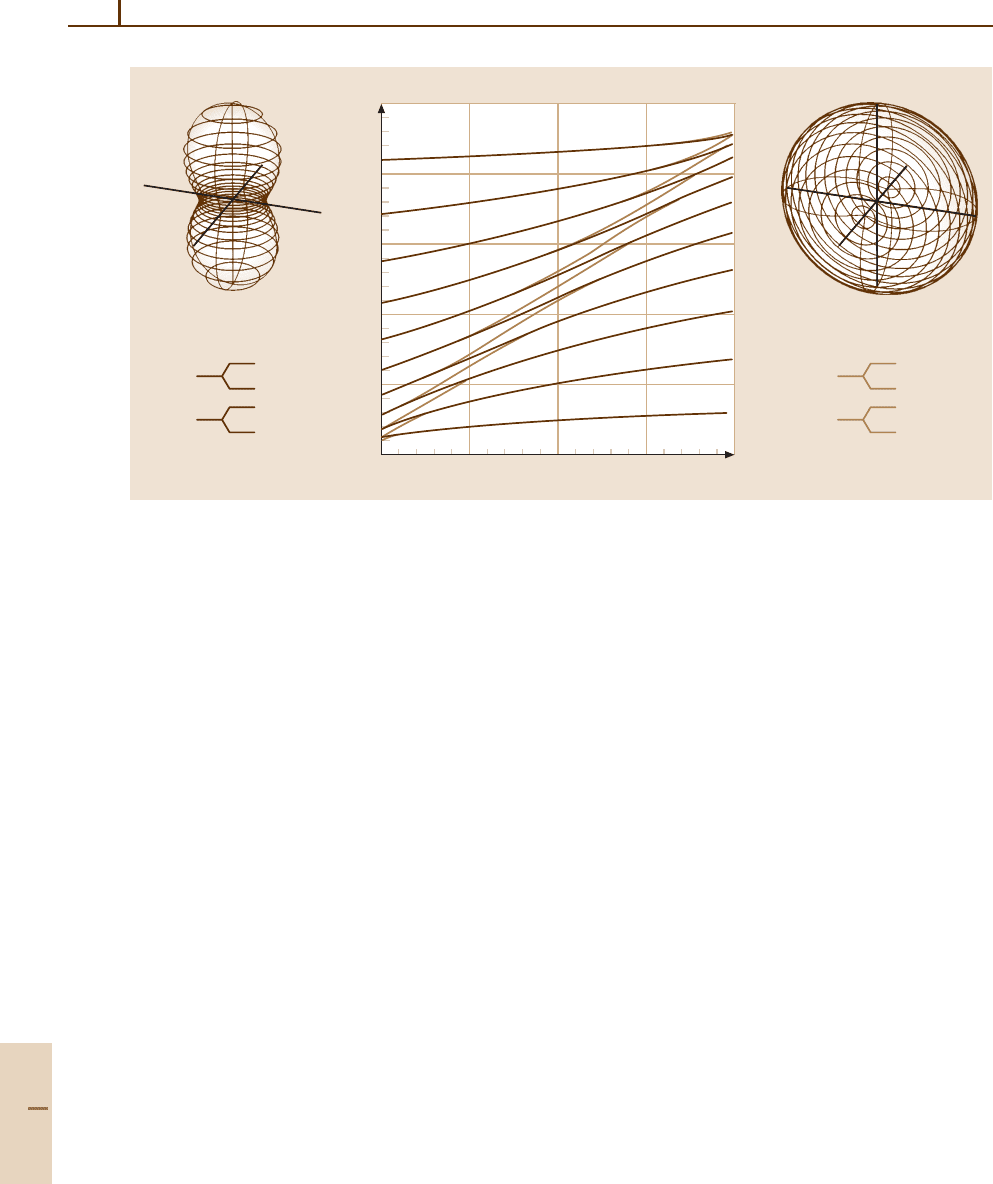
494 Part C Molecules
70.0
60.0
50.0
40.0
30.0
20.0
0.2 0.3 0.4 0.5 0.6
B=A=0.20 A B C B=C=0.60
z-type clusters
O
2
1
2
A
1
B
2
A
2
B
1
x-type clusters
O
2
1
2
B
1
A
1
B
2
A
1
Prolate Asymmetric Oblate
J=10
J = 10 eigenvalues for rigid tops (A = 0.20, C = 0.60)
Fig. 32.1 J = 10 eigenvalue plot for symmetric rigid rotors. (A =0.2, C = 0.6cm
−1
A < B < C). Prolate and oblate RE
surfaces are shown
The right hand end
A = 0.2cm
−1
, B = C = 0.6cm
−1
of the plot corresponds to an oblate symmetric top with
a descending quadratic ladder of levels, the K = 0level
being highest. Also, the internal K-axis of quantization
switches from the body z-axis for
A = B = 0.2cm
−1
,
C = 0.6cm
−1
to the body x-axis for
A = 0.2cm
−1
,
B = C = 0.6cm
−1
. Note that the lab M-degeneracy is
invisible here, but exists nevertheless.
For intermediate values of B, one has an asymmetric
top level structure and, strictly speaking, no single axis of
quantization. As a result, the eigenlevel spectrum is quite
different. A detailed display of asymmetric top levels for
the case
A = 0.2cm
−1
, B = 0.4cm
−1
, C = 0.6cm
−1
is given at the bottom of Fig. 32.2.Theyareshowntocor-
respond to semiclassical orbits discussed in Sect. 32.2.
This example is the most asymmetric top, since param-
eter B has a value midway between the symmetric top
limits of B = A and B = C.
The twenty-one J = 10 asymmetric top levels are
arranged into roughly ten asymmetry doublets and one
singlet. This resembles the symmetric top levels except
that doublets are split by varying amounts, and the sin-
glet is isolated from the other levels in the middle of the
band instead of being crowded at the top or bottom. The
doublet splittings are magnified in circles drawn next to
the levels, and these indicate that the splitting decreases
quasi-exponentially with each doublet’s separation from
the central singlet.
An asymmetric doublet splitting is also called su-
perfine structure and can be viewed as the result
of a dynamic tunneling process in a semiclassical
model of rotation [32.8–10]. Such a model clarifies
the classical-quantum correspondence for polyatomic
rovibrational dynamics in general. It can also help
to derive simple approximations for eigenvalues and
eigenvectors.
32.2 Rotational Energy Surfaces and Semiclassical Rotational Dynamics
A semiclassical model of molecular rotation can be
based upon what is called a rotational energy surface
(RES) [32.7–14]. Examples of RES for an asymmetric
topareshowninFig.32.2, and for prolate and oblate
symmetric tops in Fig. 32.1. Each surface is a radial
plot of the classical energy derived from the Hamil-
tonian (32.1) as a function of the polar direction of the
classical angular momentum J-vector in the body frame.
The magnitude of J is fixed for each surface. Note that
the J-vector in the lab frame is a classical constant of the
motion if there are no external perturbations. However,
J may gyrate considerably in the moving body frame,
Part C 32.2
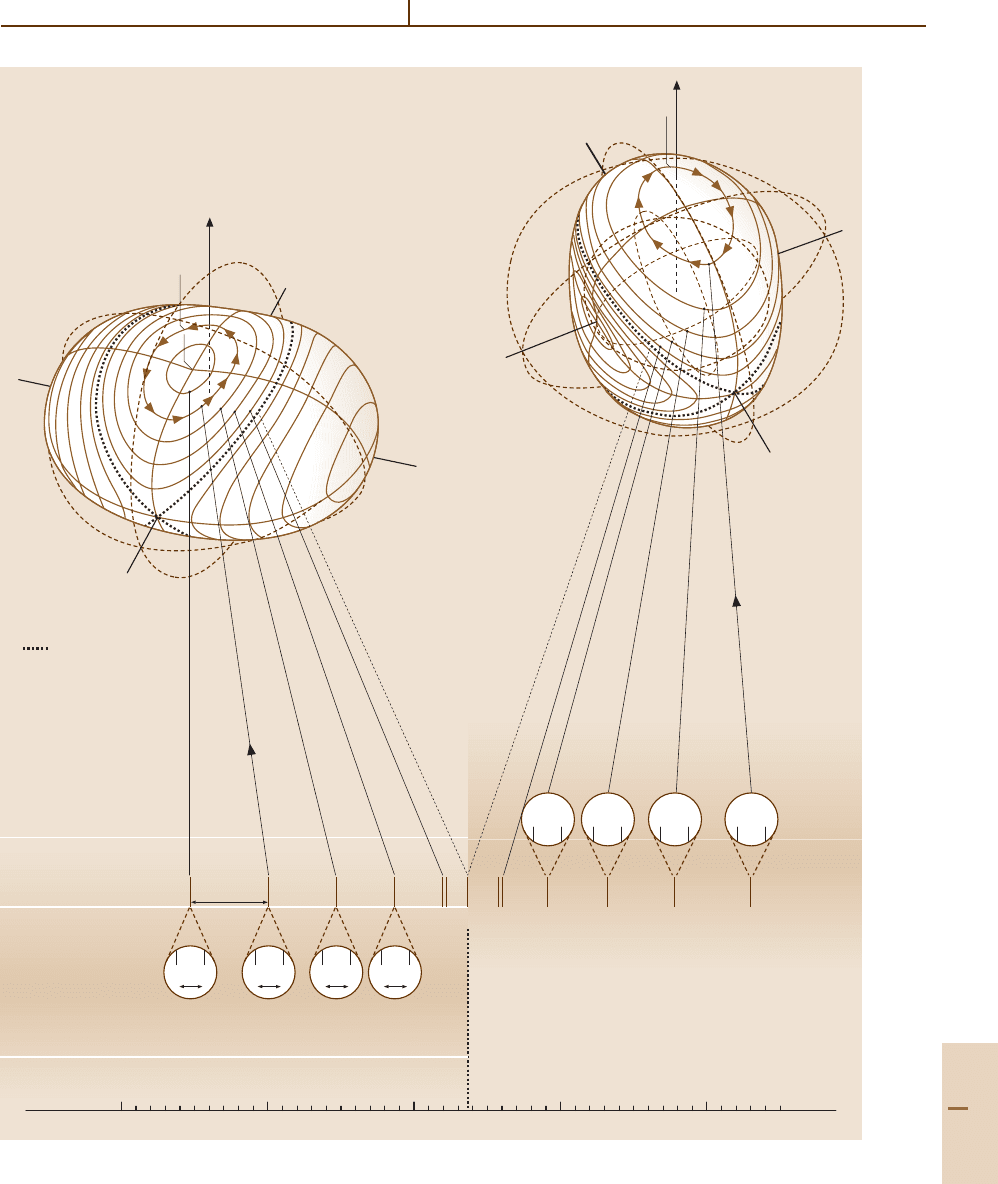
Molecular Symmetry and Dynamics 32.2 Rotational Energy Surfaces and Semiclassical Rotational Dynamics 495
20 30 40 50 60 (cm
–1
)
8.6×
10
–7
cm
–1
= 26 kHz
Rotation axes
near x
–
–axis
J
–
x
J
K
2
(x) 艑 9
J
–
z
J
–
y
J = 10
J
–
x
J
–
y
K
2
(z) 艑 10
JRotation axes
near z
–
–axis
K
2
(x) 艑 10 9 8 7
78 9
10艑 K
2
(z)
B
1
A
2
B
2
A
1
B
1
A
2
B
2
A
1
B
1
A
1
B
2
A
2
B
1
A
1
B
2
A
2
Fine structure
Superfine
structure
B
1
A
1
A
1
B
2
A
2
5.34 cm
–1
=150 GHz
7.7×
10
–5
cm
–1
= 230 kHz
2.8×
10
–3
cm
–1
= 84 MHz
5.1×
10
–2
cm
–1
= 1.5 GHz
C
2
(z)-type clustersC
2
(x)-type clusters
Separatrix
region
Fig. 32.2 J = 10 rotational energy surface and related level spectrum for an asymmetric rigid rotator
A = 0.2, B =
0.4, C = 0.6cm
−1
Part C 32.2

496 Part C Molecules
but its magnitude |J| stays the same in all frames for
free rotation.
An RES differs from what is called a constant en-
ergy surface (CES), which is obtained by simply plotting
E = H = const. in J-space using (32.1). A rigid rotor
CES is an ellipsoid covering a range of |J| values at
a single energy. An RE surface, on the other hand, is
a spherical harmonic plot at a single |J|value for a range
of energies. The latter is more appropriate for spectro-
scopic studies of fine structure, since one value of the
rotational quantum number J corresponds to a multiplet
of energy levels or transitions. An RES also shows loci
of high and low energy rotations. Also, it has roughly
the same shape as the body it represents, i. e., an RES is
long in the direction that the corresponding molecule is
long (but vice-versa for CES).
For a freely rotating molecule, the laboratory com-
ponents of the classical total angular momentum J are
constant. If one chooses to let J define the lab Z-axis,
then the direction of the J-vector in the body frame is
given by polar and body azimuthal coordinates β and γ ,
which are the second and third Euler angles, respec-
tively. (It is conventional to use the negatives −β and
−γ as polar coordinates, but this will not be necessary
here.) Then the body components of the J-vector are
written as
J
x
=
|
J
|
sin β cos γ, J
y
=
|
J
|
sin β sin γ,
J
z
=
|
J
|
cos β
, (32.7)
where the magnitude of the quantum value
|
J
|
=
√
J(J +1)
∼
=
J +
1
2
.
Substituting this into the Hamiltonian (32.1)gives
an expression for the general rigid rotor RES radius in
polar coordinates:
E(β, γ) =
H
= J( J +1)
×
sin
2
β
A cos
2
γ + B sin
2
γ
+C cos
2
β
.
(32.8)
The prolate symmetric top (A = B < C) expression
E(β) =
H
= J( J +1)
B +
(
C − B
)
cos
2
β
(32.9)
is independent of azimuthal angle γ. The 3-dimensional
plots of these expressions are shown in Figs. 32.1
and 32.2.
The RES have topography lines of constant en-
ergy (E = const.) that are the intersection of an RES
(constant |J|) with spheres of constant energy. The to-
pography lines are allowed classical paths of the angular
momentum J-vector in the body frame, since these paths
conserve both energy and momentum.
The trajectories in these figures are special ones.
They are the quantizing trajectories for total angular
momentum J = 10. For the prolate symmetric top, the
quantizing trajectories have integral values for the body
z-component K of angular momentum. According to the
Dirac vector model, angular momentum vectors trace out
a cone of altitude K and slant height |J|=
√
J(J +1).
The quantizing polar angles Θ
J
k
are given by
Θ
J
K
= cos
−1
K
√
J(J +1)
(32.10)
(K = J, J −1, ···, −J ).
These are the latitude angles of the paths on the RES
in Fig. 32.1 for K = 10, 9, 8,... ,−10. (For the oblate
RES, the angles are relative to the x-axis.) If β =
Θ
J
K
is substituted into the symmetric top RES (32.9), the
result is
E
Θ
J
K
= J( J +1)B +
(
C − B
)
K
2
, (32.11)
which is precisely the symmetric top eigenvalue (32.4).
The quantizing paths are circles lying at the intersec-
tions of the Dirac angular momentum cones and the
RES. The angle
Θ
J
K
is a measure of the angular mo-
mentum uncertainty ∆ J
x
or ∆ J
y
transverse to the z-axis
of quantization. Clearly, K =±J states have minimum
uncertainty.
For the asymmetric top, the classical paths that con-
serve both |J| and E are one of two types. First, there
are those pairs of equal-energy orbits that go around
the hills on the plus or minus end of the body z-axis,
which correspond to the ±K pairs of levels in the up-
per half of the level spectrum drawn in Fig. 32.2.Then
there are the pairs of levels belonging to the equal-energy
orbits in either of the two valleys surrounding the body
x-axis, which are associated with the pairs of levels in the
lower half of the level spectrum. Different eigensolutions
occupy different geography.
The upper pairs of paths are seen to be distorted
versions of the prolate top orbits seen on the left-hand
side of Fig. 32.1, while the lower pairs are distorted ver-
sions of the oblate top orbits seen on the right-hand
side of Fig. 32.1. The distortion makes J
z
deviate from
a constant K -value and corresponds to K -mixing in the
quantum states. This also shows that more than one
axis of quantization must be considered; the prolate-
like paths are based on the z-axis, while the oblate-like
paths belong to the body x-axis.
The two types of orbits, x and y, are separated by
what is called a separatrix curve, which crosses the sad-
Part C 32.2

Molecular Symmetry and Dynamics 32.2 Rotational Energy Surfaces and Semiclassical Rotational Dynamics 497
dle points on either side of the body y-axis. In the
example shown in Fig. 32.2, the separatrix is associ-
ated with a single level which separates the upper and
lower energy doublets. The doublets that are closer to
the separatrix level are split more than those which are
farther away. Apart from the splitting, the energy levels
can be obtained by generalized Bohr quantization of the
classical paths on the RES. The quantization condition
is,
J
z
dγ = K , (32.12a)
where
J
z
=
J(J +1)
C cos
2
γ + B sin
2
γ
− E
C cos
2
γ + B sin
2
γ
− A
(32.12b)
follows from (32.7)and(32.8). The resulting E
K
-values
are obtained by iteration.
The doublet, or superfine, splitting is a quantum ef-
fect which may be associated with tunneling between
orbits that would have had equal energies E
K
in the
purely classical or semiclassical model. Approximate
tunneling rates are obtained from integrals over the sad-
dle point between each pair of equal-energy quantizing
paths. The K-th rate, or amplitude, is,
S
K
= ν
K
e
−P
K
, (32.13)
where
P
K
= (32.14)
i
γ +
γ −
dγ
J(J +1)
C cos
2
γ + B sin
2
γ
− E
K
C cos
2
γ + B sin
2
γ
− A
is the saddle path integral between the points of closest
approach, γ + and γ −,andν
K
is the classical preces-
sion frequency or quantum level spacing around energy
level E
K
. Since there are two tunneling paths, the ampli-
tude S
K
is doubled in a tunneling Hamiltoni an matrix
for the K-th semiclassical doublet of z and −z =
z paths:
H
K
=
E
K
2S
K
2S
K
E
K
|
z
|
z
.
(32.15)
The resulting tunneling energy eigensolutions are given
in Table 32.1.
A-orB-states correspond to symmetric and anti-
symmetric combinations of waves localized on the two
semiclassical paths. Rotational symmetry is considered
in Sect. 32.3.
The total doublet splitting is 4S
K
, and decreases
exponentially with the saddle path integral (32.14).
The superfine A–B splittings in Fig. 32.2 are seen to
range from several GHz near the separatrix down to
only 26 kHz for the highest-K doublets at the band
edges.
Meanwhile, the typical interdoublet level spacing
or classical precessional frequency is about 150 GHz
for the J = 10 levels shown in Fig. 32.2.ThisK -level
spacing is called rotational fine structure splitting, and
is also present in the symmetric top case. (The superfine
splitting of the symmetric top doublets is exactly zero,
since they have O(2)
BODY
symmetry if A = B or B =C.
In this case, all tunneling amplitudes cancel.)
The classical precession of J in the body frame
follows a “left-hand rule” similar to what meteorolo-
gists use to determine Northern Hemisphere cyclonic
rotation. A left “thumbs-down” or “low” has counter-
clockwise precession as does an oblate rotor valley, but
a prolate RES “high” supports clockwise motion just
like a weather “high”.
Finally, consider the spacing between adjacent
J-levels, which is called rotational structure, in a spec-
trum. This spacing is
E(J, K ) − E(J −1, K ) = 2BJ ,
(32.16)
according to the symmetric top energy formulas (32.4).
For the example just treated, 2BJ is about 10 cm
−1
or
300 GHz. This corresponds to the actual rotation fre-
quency of the body. It is the only kind of rotational
dynamics or spectrum that is possible for a simple di-
atomic rotor. A diatomic molecule, however, can have
internal electronic or nuclear spin rotation, which gives
an additional fine structure as discussed later [32.1,6,15].
To summarize, polyatomic molecules can be ex-
pected to exhibit all three types of rotational motion and
spectra (from faster to slower): rotational, precessional,
and precessional tunneling. These are related to three
kinds of spectral structure (from coarser to finer spec-
tra): rotational structure, fine structure, and superfine
structure, respectively. Again, this neglects internal ro-
tational and spin effects, which can have abnormally
strong rotational resonance coupling due to the superfine
structure [32.9,16]. Examples of this are discussed at the
end of this chapter.
Table 32.1 Tunneling energy eigensolutions
Eigenvectors
|
z
|z
Eigenvalues
|
A
1 1 E
A
(K) = E
K
+2S
K
|
B
1 −1 E
B
(K) = E
K
−2S
K
Part C 32.2

498 Part C Molecules
32.3 Symmetry of Molecular Rotors
Molecular rotational symmetry is most easily intro-
duced using examples of rigid rotors. Molecular rotor
structures may have more or less internal molecular
symmetry, depending on how their nuclei are positioned
relative to one another in the body frame. A molecule’s
rotational symmetry is described by one of the elemen-
tary rotational point symmetry groups. These are the
n-fold axial cyclic groups C
n
and polygonal dihedral
groups D
n
(n = 1, 2,...), the tetrahedral group T ,the
cubic-octahedral group O, or the icosahedral group Y.
All other point groups, such as C
nv
, T
d
,andO
h
,are
a combination of an elementary point group with the
inversion operation I(r →−r). Each of these groups
consist of operations which leave at least one point (ori-
gin) of a structure fixed while mapping identical atoms
or nuclei into each other in such a way that the appear-
ance of the structure is unchanged. The point groups are
subgroups of the nuclear permutation groups [32.17].
In other words, molecular symmetry is based upon
one of the most fundamental properties of atomic
physics: the absolute identity of all atoms or, more pre-
cisely, nuclei of a given atomic number Z and mass
number A. It is the identity of the so-called ‘elemen-
tary’ electronic and nucleonic constituent particles that
underlies the symmetry.
The Pauli principle states that all half-integer spin
particles are antisymmetrized with every other one of
their kind in the universe. The Pauli–Fermi antisym-
metrization principle and the related Bose–Einstein
symmetrization principle determine much of molecu-
lar symmetry and dynamics, just as the Pauli exclusion
principle is fundamental to electronic structure.
32.3.1 Asymmetric Rotor Symmetry Analysis
For an asymmetric rigid rotor, any rotation which inter-
changes x−, y−,orz-axes of the body cannot possibly
be a symmetry, since all three axes are assumed to have
different inertial constants. This restricts one to consider
only 180
◦
rotations about the body axes, and these are
the elements of the rotor groups C
2
and D
2
.
The two symmetry types for C
2
are even (denoted
A or 0
2
) and odd (denoted B or 1
2
) with respect to
a 180
◦
rotation. For D
2
, which is just C
2
⊗C
2
, the four
C
2
1 R
A 1 1
B 1 −1
Table 32.2 Character table for
symmetry group C
2
symmetry types are even-even (denoted A
1
), even-odd
(denoted A
2
), odd-even (denoted B
1
), and odd-odd (de-
noted B
2
) with respect to 180
◦
rotations about the y-and
x-axes, respectively. (The z-symmetry is determined by
a product of the other two since R
z
= R
x
R
y
.) This is
summarized in the character Tables 32.2 and 32.3.
The RES for the rigid rotor shown in Fig. 32.2 is in-
variant under 180
◦
rotations about each of the three body
axes. Therefore, its Hamiltonian symmetry is D
2
and its
quantum eigenlevels must correspond to one of the four
types listed under D
2
in Table 32.3.TheD
2
symme-
try labels are called rotational (or in general rovibronic)
species of the molecular state. The species label the sym-
metry of a quantum wave function associated with a pair
of C
2
symmetric semiclassical paths.
The classical J-paths come in D
2
symmetric pairs,
but each individual classical J-path on the rigid rotor
RES has a C
2
symmetry which is a subgroup of D
2
. Each
path in the valley around the x-axis is invariant under
just the 180
◦
rotation around the x-axis. This is C
2
(x)
symmetry. The other member of its pair that goes around
the negative x-axis also has this local C
2
(x) symmetry.
The combined pair of paths has the full D
2
symmetry but
classical mechanics does not permit occupation of two
separate paths. Multiple path occupation is a completely
quantum effect.
Similarly, each individual J-path on the hill around
the z-axis is invariant under just the 180
◦
rotation around
the z-axis, so it has C
2
(z) symmetry as does the equiva-
lent path around the negative z-axis. Only the separatrix
has the full D
2
symmetry, since its pairs are linked up
on the y-axis to form the boundary between the x and
z paths. No J -paths encircle the unstable y-axis since it
is a saddle point.
Each classical J-path near the x-orz-axis belongs
to a particular K -value through the semiclassical quan-
tization conditions (32.12). Depending upon whether
the K-value is even (0
2
) or odd (1
2
), the correspond-
ing K-doublet is correlated with a pair of D
2
species
as shown in the columns of the correlation tables
in Fig. 32.3. These three correlation tables give the axial
Table 32.3 Character table for symmetry group D
2
D
2
1 R
x
R
y
R
z
A
1
1 1 1 1
A
2
1 −1 1 −1
B
1
1 1 −1 −1
B
2
1 −1 −1 1
Part C 32.3
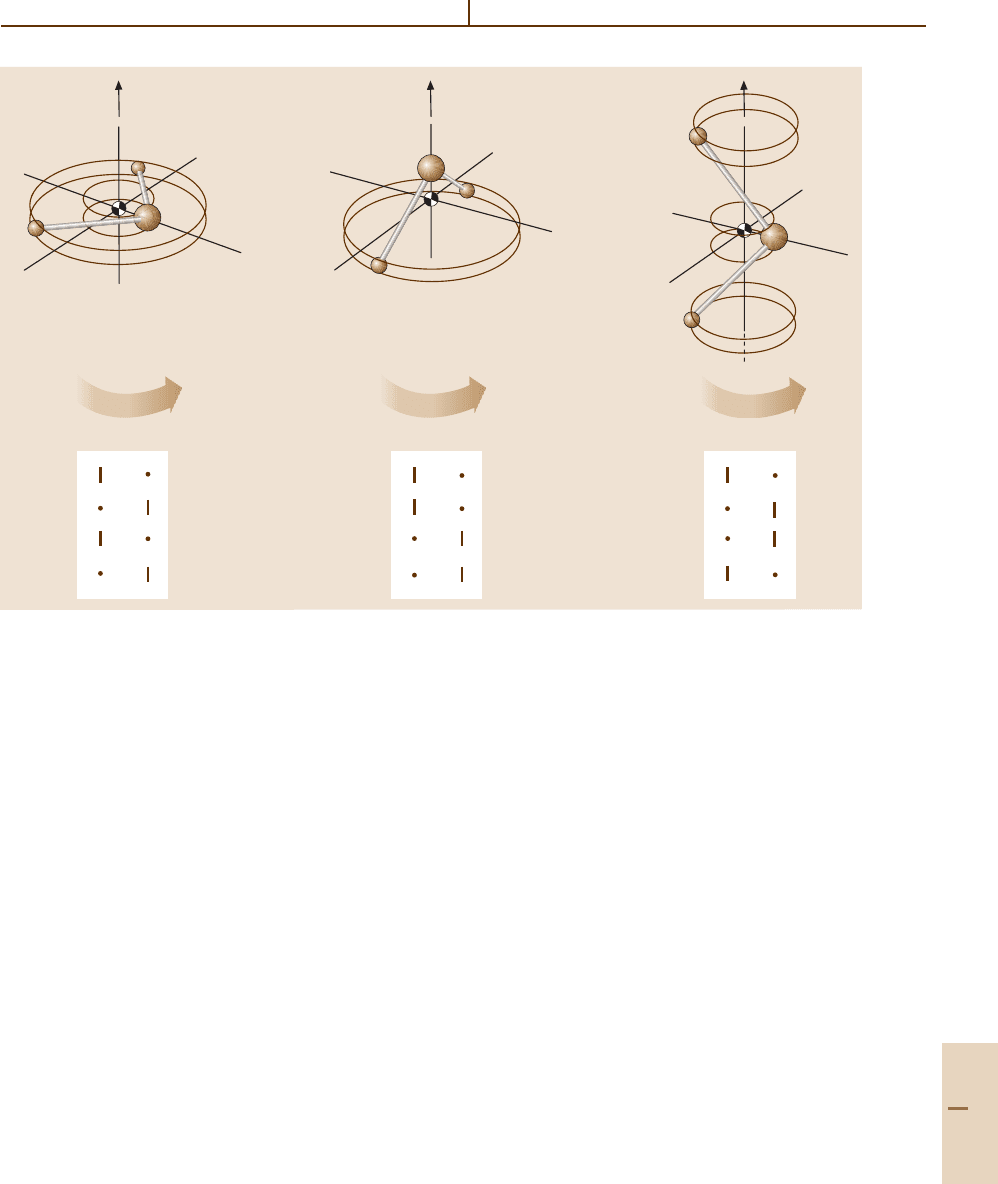
Molecular Symmetry and Dynamics 32.4 Tetrahedral-Octahedral Rotational Dynamics and Spectra 499
J
x
–
z
–
y
–
C
2
(x) C
2
(y)
J
y
–
z
–
x
–
J
z
–
y
–
x
–
C
2
(z)
K
2
(x) K
2
(y)
K
2
(z)
A
1
A
2
B
1
B
2
O
2
I
2
A
1
A
2
B
1
B
2
O
2
I
2
A
1
A
2
B
1
B
2
O
2
I
2
Fig. 32.3 Tables of correlations between D
2
symmetry species and the even (0
2
) and odd (I
2
) symmetric species of
subgroups C
2
(x), C
2
(y),andC
2
(z)
180
◦
rotational symmetry of each D
2
species for rota-
tion near each body axis x, y and z, respectively, but
only the stable rotation axes x and z support stable path
doublets for this Hamiltonian (32.1).
For example, consider the K = 10 paths which lie
lowest in the x-axis valleys. Since K = 10 is even (0
2
),
it is correlated with an A
1
and B
1
superfine doublet
[see the 0
2
column of the C
2
(x) table]. On the high
end near the z-axis hilltop, K = 10 gives rise to an A
1
and B
2
doublet [see the 0
2
column of the C
2
(z) table].
All the doublets in Fig. 32.2 may be assigned in this
way.
32.4 Tetrahedral-Octahedral Rotational Dynamics and Spectra
The highest symmetry rigid rotor is the spherical top for
which the three inertial constants are equal (A = B = C).
The spherical top Hamiltonian
H = B J· J
has the full R(3)
LAB
⊗ R(3)
BODY
symmetry. With in-
version parity, the symmetry is O(3)
LAB
⊗O(3)
BODY
.
In any case, the J-levels are (2J +1)
2
-fold degener-
ate. The resulting BJ( J +1) energy expression is the
first approximation for molecules which have regular
polyhedral symmetry of, for example, a tetrahedron
(CF
4
), cube (C
6
H
6
), octahedron (SF
6
), dodecahedron
or icosahedron (C
20
H
20
,B
12
H
12
,orC
60
). Rigid regular
polyhedra have isotropic or equal inertial constants and
rotate just like they were perfectly spherical distributions
of mass.
However, no molecule can really have spherical
O(3)
BODY
symmetry; even molecules of the highest
symmetry contain a finite number of nuclear mass
points, and therefore have a finite internal point sym-
metry. Evidence of octahedral or tetrahedral symmetry
shows up in fine structure splittings analogous to those
for asymmetric tops. However, spherical top fine struc-
ture is due to symmetry breaking caused by anisotropic
or tensor rotational distortion. To discuss this, one needs
to consider what are called semirigid rotors.
Part C 32.4

500 Part C Molecules
32.4.1 Semirigid Octahedral Rotors
and Centrifugal Tensor Hamiltonians
The lowest order tensor centrifugal distortion pertur-
bation has the same form for both tetrahedral and
octahedral molecules. It is simply a sum of fourth powers
of angular momentum operators given in the third term
below. The first two terms are the scalar rotor energy
and scalar centrifugal energy.
H = B
|
J
|
2
+ D
|
J
|
4
+10t
044
×
J
4
x
+ J
4
y
+ J
4
z
−(3/5)J
4
.
(32.17)
The tensor term includes the scalar (3/5)J
4
to preserve
the center of gravity of the tensor level splitting. This
type of semirigid rotor Hamiltonian was first used in the
study of methane (CH
4
) spectra [32.18].
The scalar terms do not reduce the symmetry or
split the levels. The tensor term (t
044
) breaks the
molecular symmetry from O(3)
LAB
⊗ O(3)
BODY
to
the lower symmetry subgroup O(3)
LAB
⊗T
dBODY
,or
O(3)
LAB
⊗O
hBODY
, and splits the (2J +1)
2
-fold de-
generacy into intricate fine structure patterns which are
analogous to cubic crystal field splitting of atomic or-
bitals. The first calculations of the tensor spectrum were
done by direct numerical diagonalization [32.18–21]. As
a result, many of the subtle symmetry properties were
missed. The semiclassical analysis [32.22] described in
the following Sections exposes these properties.
32.4.2 Octahedral and Tetrahedral
Rotational Energy Surfaces
By substituting in (32.7) and plotting the energy as
a function of body polar angles β and γ ,anRES is
obtained, two views of which are shown in Fig. 32.4.
Here the tensor term is exaggerated in order to exhibit
the topography clearly. (In (n = 0) SF
6
,thet
044
coeffi-
cient is only about 5.44 Hz, while the rotational constant
is B = 0.09 cm
−1
.Thet
244
coefficient of (n = 1) SF
6
is
much greater.)
A positive tensor coefficient (t
a44
> 0) gives an oc-
tahedral shaped RES, as shown in Fig. 32.4.Thisis
appropriate for octahedral molecules since they are least
susceptible to distortion by rotations around the x-, y-,
and z-axes containing the strong radial bonds. Thus the
rotational energy is highest for a J-vector near one of
six body axes (±1, 0, 0), (0, ±1, 0),or(0, 0, ±1),i.e.,
one of the six RES hills in Fig. 32.4.
However, if the J-vector is set in any of the eight
interaxial directions (±1, ±1, ±1), the centrifugal force
will more easily bend the weaker angular bonds, raise the
molecular inertia, and lower the rotational energy. This
accounts for the eight valleys on the RES in Fig. 32.4.
A negative tensor coefficient (t
a44
< 0) gives a cubic
shaped RES. This is usually appropriate for cubic and
tetrahedral molecules, since they are most susceptible
to distortion by rotations around the x-, y-, and z-axes
which lie between the strong radial bonds on the cubic
diagonals. Instead of six hills and eight valleys, one
finds six valleys and eight hills on the cubic RES.Both
freon CF
4
and cubane C
8
H
8
are examples of this type
of topology.
Note that a semirigid tetrahedral rotor may have the
same form of rotational Hamiltonian and RE surface as
a cubic rotor. The four tetrahedral atomic sites are in
the same directions as four of the eight cubic sites. The
other four cubic sites form an inverted tetrahedron of the
same shape.
If only tetrahedral symmetry were required, the
Hamiltonian could contain a third order tensor of the
form J
x
J
y
J
z
. However, pure rotational Hamiltonians
must also satisfy time-reversal symmetry: the energy
for each J must be the same as for −J, and thus rota-
tional sense should not matter. This symmetry excludes
all odd powers of J. Simple rotor RES have inversion
symmetry even if their molecules do not. Compound ro-
tors containing spins or other rotors may have “lopsided”
pairs of RES as shown in Sect. 32.6.
32.4.3 Octahedral and Tetrahedral
Rotational Fine Structure
An example of rotational fine structure for angular mo-
mentum quantum number J = 30 is shown in Fig. 32.4.
The levels consist mainly of clusters of levels be-
longing to the octahedral symmetry species A
1
, A
2
,
E, T
1
,orT
2
. The characters of these species are
giveninTable32.4. (The tetrahedral T
d
group has
a similar table where T
1
and T
2
are often labeled F
1
and F
2
).
The first column gives the dimension or degeneracy
of each species; A
1
, A
2
, are singlets, E is a doublet,
Table 32.4 Character table for symmetry group O
O 0
◦
120
◦
180
◦
90
◦
180
◦
A
1
1 O1 1 1 1
A
2
1 1 1 −1 −1
E 2 −1 2 0 0
T
1
3 0 −1 1 −1
T
2
3 0 −1 −1 1
Part C 32.4
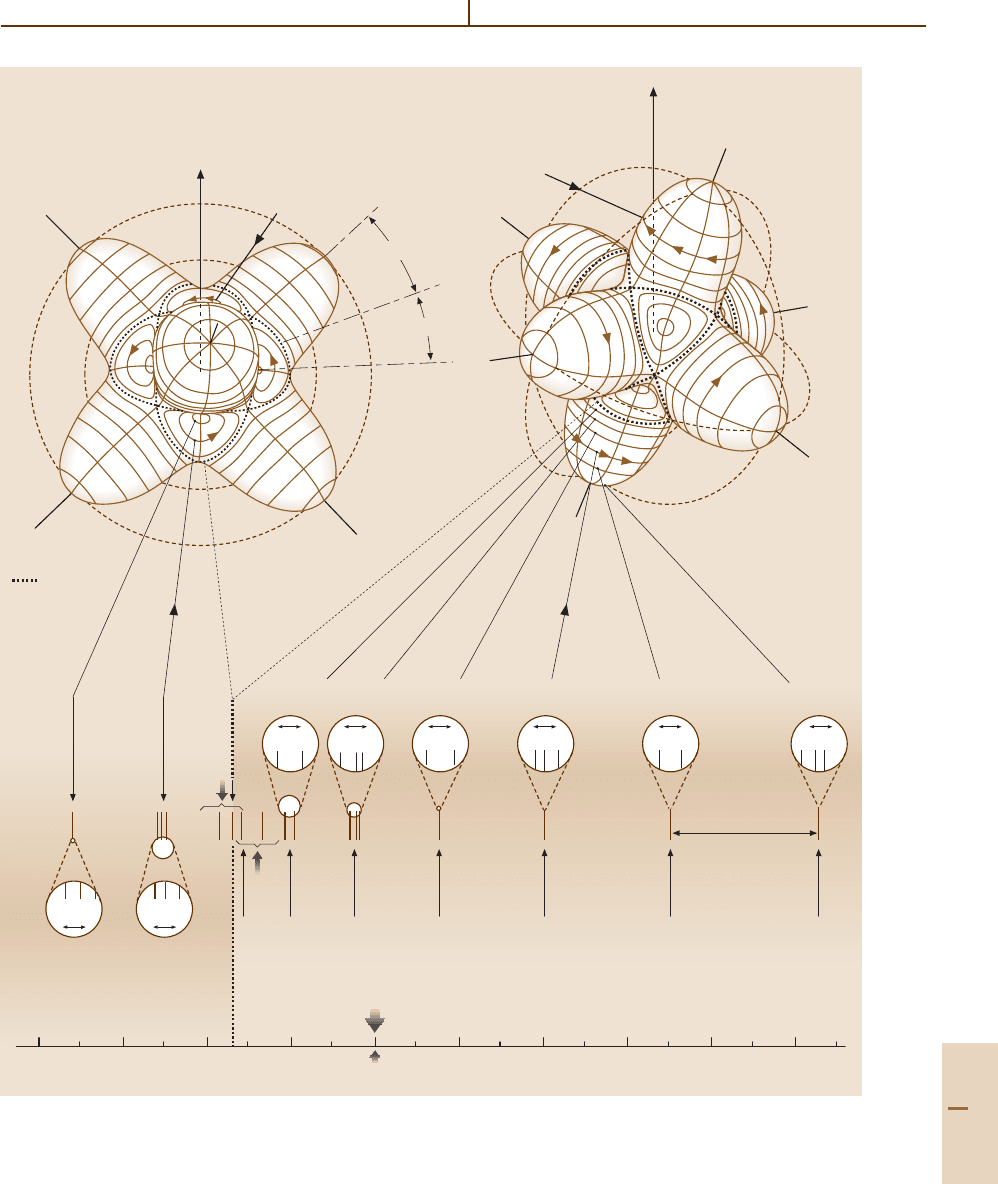
Molecular Symmetry and Dynamics 32.4 Tetrahedral-Octahedral Rotational Dynamics and Spectra 501
J
–
x
J
K
3
艑 29
J
–
y
35.3°
19.5°
J = 30
J
–
x
J
–
y
K
4
艑 28
J
J
–
z
9.4 ×
10
–6
cm
–1
T
1
T
2
A
1
T
2
ET
1
T
2
EA
1
A
2
T
1
T
2
ET
1
T
2
5.0 ×
10
–6
cm
–1
5.7 ×
10
–7
cm
–1
9.2 ×
10
–8
cm
–1
3.8 ×
10
–9
cm
–1
1.6 ×
10
–10
cm
–1
= 48Hz
1.8 × 10
–4
cm
–1
= 5.3 MHz
T
2
T
1
A
1
E
T
2
T
1
E
A
1
T
1
T
2
A
2
1.0 × 10
–6
cm
–1
8.1 × 10
–6
cm
–1
(0
3
)K
3
= 30
(2
3
)K
3
= 29
(1
3
)K
3
= 28
K
4
=
24(0
4
)
K
4
=
25(1
4
)
K
4
=
26(2
4
)
K
4
=
27(3
4
)
K
4
=
28(0
4
)
K
4
=
29(1
4
)
K
4
=
30(2
4
)
C
3
clusters C
4
clusters
84.70719 cm
–1
Relative units of 10
–4
cm
–1
= 3.0 MHz
–4–3–2–1 12345
Separatrix
region
Fig. 32.4 J = 10 rotational energy surface related level spectrum for a semirigid octahedral or thetrahedral rotor
while T
1
and T
2
are triplets. These species form two
clusters (A
1
, T
1
, T
2
, A
2
) and (T
2
, E, T
1
) on the low
end of the spectrum and six clusters (T
1
, T
2
), ( A
2
, T
2
,
E), (T
1
, T
2
), (E, T
1
, A
1
), (T
1
, T
2
), and (A
2
, T
2
, E)on
Part C 32.4
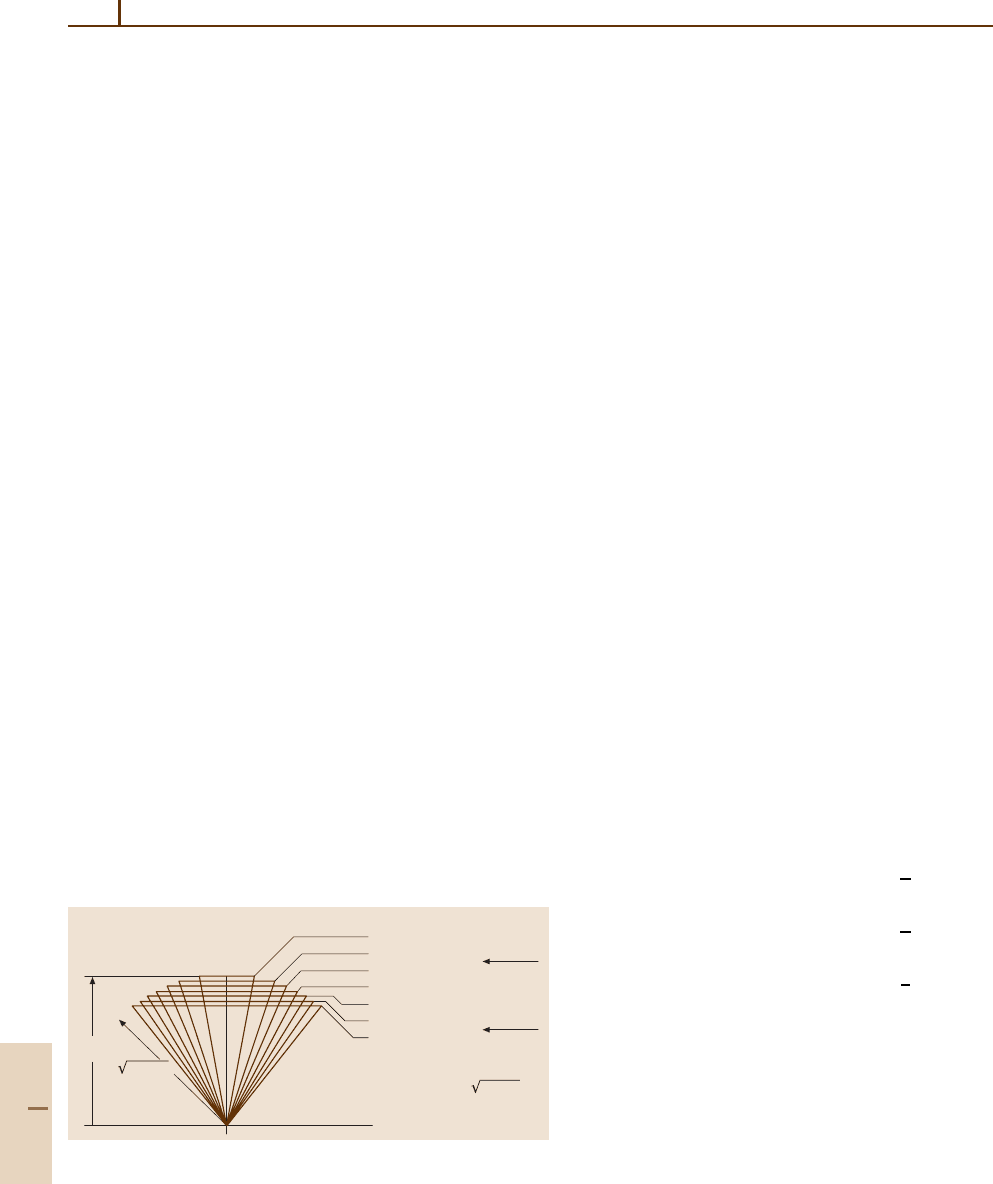
502 Part C Molecules
the upper part of the spectrum. (See the right-hand side
of Fig. 32.4). Note that the total dimension or (near) de-
generacy for each of the two lower clusters is eight:
(1 +3 +3 +1) and (3 +2 +3), while the upper clus-
ters each have a six-fold (near) degeneracy: (3 +3),
(1 +3 +2), etc.
Each of the two lower eight-fold clusters can be as-
sociated with semiclassical quantizing paths in an RES
valley as shown in Fig. 32.4. The eight-fold dimension
or (near) degeneracy occurs because each quantizing
path is repeated eight times – once in each of the eight
identical valleys. Similarly, the six-fold cluster dimen-
sion occurs because there are six identical hills, and
each quantizing path is repeated six times around the
surface.
The majority of the paths lie on the hills because the
hills are bigger than the valleys. The hills subtend a half
angle of 35.3
◦
to the separatrix, while the valleys only
have 19.5
◦
. To estimate the number of paths or clusters
in hills or valleys, the angular momentum cone angles
for J = 30 may be calculated using (32.10). The results
are displayed in Fig. 32.5. The results are consistent with
the spectrum in Fig. 32.4. Only the two highest K-values
of K = 29, 30 have cones small enough to fit in the
valleys, but the six states of K = 25–30 can all fit onto
the hills.
The angular momentum cone formula also provides
an estimate for each level cluster energy. The estimates
become more and more accurate as K increases (ap-
proaching J ), while the uncertainty angle Θ
J
K
decreases.
Paths for higher K are more nearly circular and there-
fore more nearly correspond to symmetric top quantum
states of pure K . The paths on octahedral RE surfaces
are more nearly circular for a given K than are those
on the asymmetric top RE surface, and so the octahe-
dral rotor states can be better approximated by those of
a symmetric top.
Angular momentum cones for
J =30
30
Θ = 10.3° K =30
Θ = 18.0° K =29
Θ = 23.3° K =28
Θ = 27.7° K =27
Θ = 31.5° K =26
Θ = 34.9° K =25
Θ = 38.1° K =24
3-fold
cutoff
19.5°
4-fold
cutoff
35.3°
Θ = arc cos [K/ J(J+1)]
30(31)
Fig. 32.5 J = 30 angular momentum cone half angles and octahe-
dral cutoffs
32.4.4 Octahedral Superfine Structure
The octahedral RES has many more local hills and
valleys and corresponding types of semiclassical paths
than are found on the rigid asymmetric top RES.The
tunneling between multiple paths produces an octahe-
dral superfine structure that is more complicated than
the asymmetric top doublets. Still, the same symmetry
correlations and tunneling mechanics may be used.
First, the octahedral symmetry must be correlated
with the local symmetry of the paths on the hills and in
the valleys. The hill paths have a C
4
symmetry while
the valley paths have a local C
3
symmetry. This is seen
most clearly for the low-K paths near the separatrix
which are less circular. The C
3
and C
4
correlations are
giveninFig.32.6 with a sketch of the corresponding
molecular rotation for each type of path.
To find the octahedral species associated with a K
3
=
30 path in a C
3
valley one notes that 30 is 0 modulo 3.
Hence the desired species are found in the 0
3
column
of the C
3
correlation table: (A
1
, A
2
, T
1
, T
2
).Thisis
what appears (not necessarily in that order) in the lower
left corner of Fig. 32.4. Similarly, the species ( A
2
, E,
T
2
) for a K
4
= 30 path on top of a C
4
hill are found in
the 2
4
column of the C
4
correlation table since 30 is 2
modulo 4; these appear on the other side of Fig. 32.4.
Clusters (T
1
, T
2
) for K
4
= 29 and (A
1
, E, T
1
) for K
4
=
28 are found in a similar manner.
A multiple path tunneling calculation analogous to
the one for rigid rotors can be applied to approximate oc-
tahedral superfine splittings. Consider the cluster (A
1
, E,
T
1
) for K
4
= 28, for example. Six C
4
-symmetric paths
located on octahedral vertices on opposite sides of the x-,
y-, and z-axes may be labeled {|x, |
¯
x, |y, |
¯
y, |z, |
¯
z}.
A tunneling matrix between the six paths follows:
H
K
4
=28
=
H 0 SSSS
0 HSSSS
SSH0 SS
SS0 HSS
SSSSH0
SSSS0 H
|
x
|
x
|
y
|
y
|
z
|
z
,
(32.18)
where the tunneling amplitude between nearest neigh-
bor octahedral vertices is S, but is assumed to be zero
between antipodal vertices. The eigenvectors and eigen-
values for this matrix are given in the Table 32.5.
This predicts that the triplet (T
1
) level should fall be-
tween the singlet ( A
1
) and the doublet (E)levelsand
the singlet-triplet spacing (4S) should be twice the split-
Part C 32.4
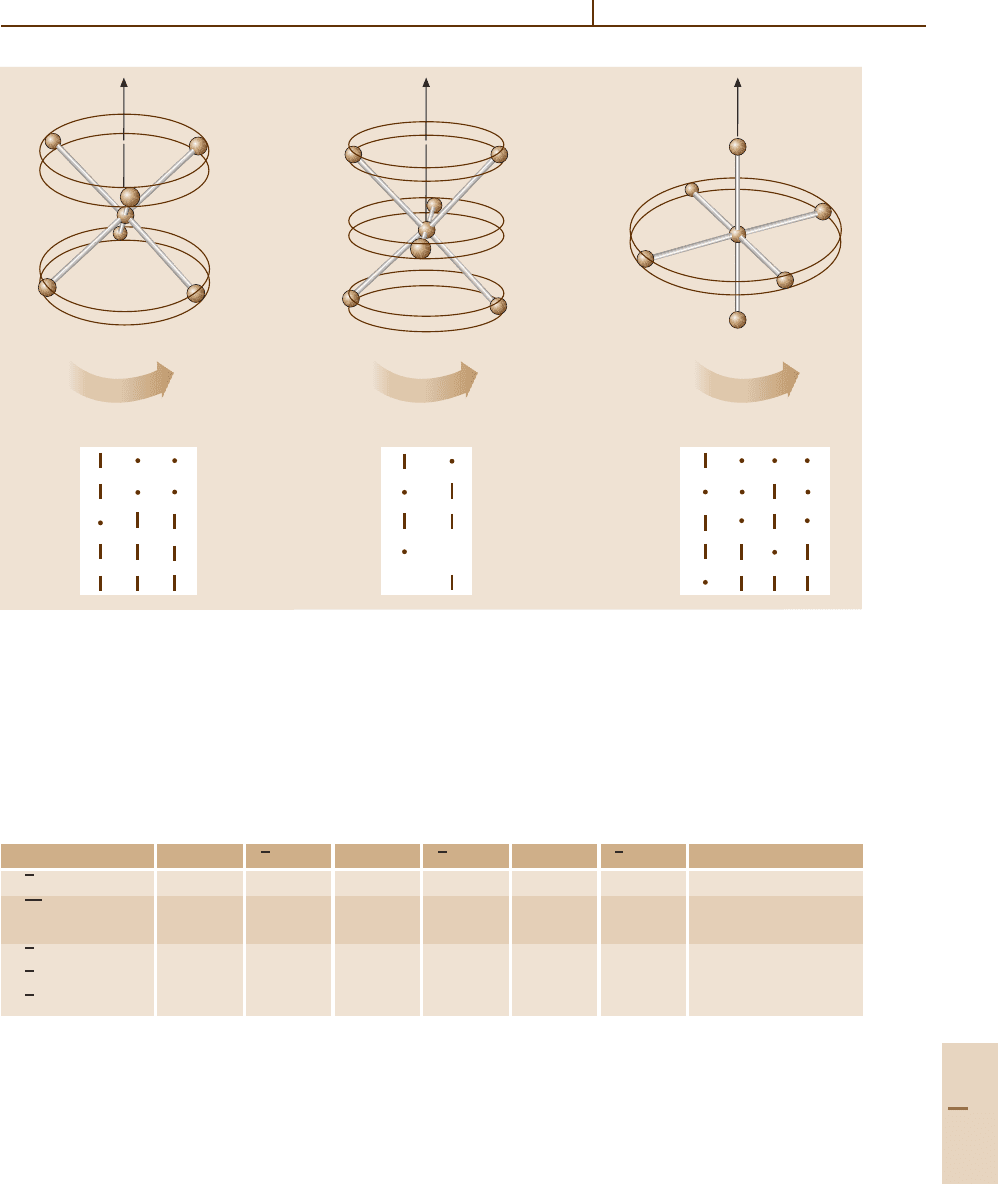
Molecular Symmetry and Dynamics 32.5 High Resolution Rovibrational Structure 503
J
C
3
C
2
K
3
K
2
K
4
A
1
A
2
E
T
2
O
3
1
3
A
1
A
2
T
1
T
2
O
2
1
2
2
3
T
1
E
2
2
A
1
A
2
E
T
2
O
4
1
4
2
4
T
1
3
4
C
4
JJ
Fig. 32.6 Tables of correlations between 0 symmetry species and the cyclic axial symmetry species (K
p
means K mod p)
of subgroups C
3
, C
2
and C
4
ting (-2S) between the triplet and doublet. This 2 : 1
ratio is observed in the (E, T
1
, A
1
) and ( A
2
, T
2
, E)
clusters which can be resolved and also in numerical
calculation [32.18–21].
The tunneling amplitudes can be calculated by a sep-
aratrix path integral analogous to the asymmetric top
Table 32.5 Eigenvectors and eigenvalues of the tunneling matrix for the (A
1
, E, T
1
) cluster with K = 28
Eigenvector
|
x
|
x
|
y
|
y
|
z
|
z
Eigenvalue
√
6
|
A
1
=
1 1 1 1 1 1 E
A
1
= H +4S
√
12
|
E, 1
= 2 2 −1 −1 −1 −1 E
E
= H −2S
2
|
E, 2
=
0 0 1 1 −1 −1
√
2
|
T
1
, 1
= 1 −1 0 0 0 0 E
T
1
= H
√
2
|
T
1
, 2
= 0 0 1 −1 0 0
√
2
|
T
1
, 3
= 0 0 0 0 1 −1
formula (32.13) [32.10, 11]. As shown in Fig. 32.4,the
tunneling rates or superfine splittings near the sep-
aratrix are ∼ 1 MHz, which is only slightly slower
than the classical precessional frequency. But as K ap-
proaches J on the hilltops, the tunneling rate slows down
to a few Hz.
32.5 High Resolution Rovibrational Structure
A display of spectral hierarchy for higher and higher
resolution is shown in Fig. 32.7 for the 630 cm
−1
or
16 µm bands of CF
4
. This will serve to summarize
the possible rovibrational spectral structures and place
them in a larger context. The ν
4
resonance in part (a)
corresponds to a dipole active n
4
= 0 → 1 vibrational
Part C 32.5
